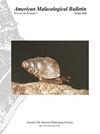Population Differences in Fecundity Components in the Hermaphroditic Freshwater Snail Planorbella trivolvis
IF 0.4
4区 生物学
Q4 MARINE & FRESHWATER BIOLOGY
引用次数: 3
Abstract
Abstract: Fecundity in outcrossing species can be influenced by both maternal and paternal parents. To tease out these influences, we observed egg production in two populations of the hermaphroditic freshwater snail, Planorbella trivolvis (Say 1817). We carried out both intra- and inter-population matings between individuals from an inbred albino laboratory strain and individuals one generation removed from a natural population, and measured egg production for two 3-week periods - immediately after mating and 11 weeks later. In the female role, individuals from the albino laboratory population produced significantly more egg masses than the wild derived snails, regardless of whether they were mated to a partner of wild or laboratory origin, indicating that egg mass production is controlled by the maternal parent. Conversely, regardless of their own origin (laboratory or wild), snails mated to individuals from the wild derived population laid more eggs in each egg mass than those fertilized by sperm from the lab population. These results indicate that the number of egg masses a snail lays is determined at least in part by a maternal contribution, and that the number of eggs deposited in each mass may be influenced by the origin of the sperm donor. In addition, we confirmed a short-term trade-off between growth and reproduction as differences in egg production among mating types were mirrored by differences in body size. Further investigation into the nature of these differences will lead to better understanding of the reproductive biology of these hermaphrodite mollusks.雌雄同体淡水蜗牛繁殖力组成的种群差异
摘要:异交种的繁殖力受父母双方的影响。为了找出这些影响,我们观察了两性淡水蜗牛Planorbella trivolvis(1817年)的两个种群的产卵情况。我们在近交白化病实验室菌株的个体和从自然种群中分离一代的个体之间进行了种群内和种群间交配,并测量了交配后和11周后两个3周的卵子产量。在雌性角色中,白化病实验室种群的个体产生的卵子数量明显多于野生蜗牛,无论它们是与野生还是实验室来源的伴侣交配,这表明卵子的大量生产由母体控制。相反,无论其自身来源(实验室或野生)如何,与野生种群的个体交配的蜗牛在每个卵子中产下的卵子都比实验室种群精子受精的蜗牛多。这些结果表明,蜗牛产下的卵子数量至少部分由母体贡献决定,每个卵子中沉积的卵子数量可能受到精子捐献者来源的影响。此外,我们证实了生长和繁殖之间的短期权衡,因为不同交配类型的卵子产量差异反映在体型差异上。进一步研究这些差异的性质将有助于更好地了解这些雌雄同体软体动物的生殖生物学。
本文章由计算机程序翻译,如有差异,请以英文原文为准。
求助全文
约1分钟内获得全文
求助全文
来源期刊
CiteScore
1.00
自引率
40.00%
发文量
1
审稿时长
>12 weeks
期刊介绍:
The American Malacological Bulletin serves as an outlet for reporting notable contributions in malacological research. Manuscripts concerning any aspect of original, unpublished research,important short reports, and detailed reviews dealing with molluscs will be considered for publication. Recent issues have included AMS symposia, independent papers, research notes,and book reviews. All published research articles in this journal have undergone rigorous peer review, based on initial editor screening and anonymous reviewing by independent expertreferees. AMS symposium papers have undergone peer review by symposium organizer, symposium participants, and independent referees.

 求助内容:
求助内容: 应助结果提醒方式:
应助结果提醒方式:


